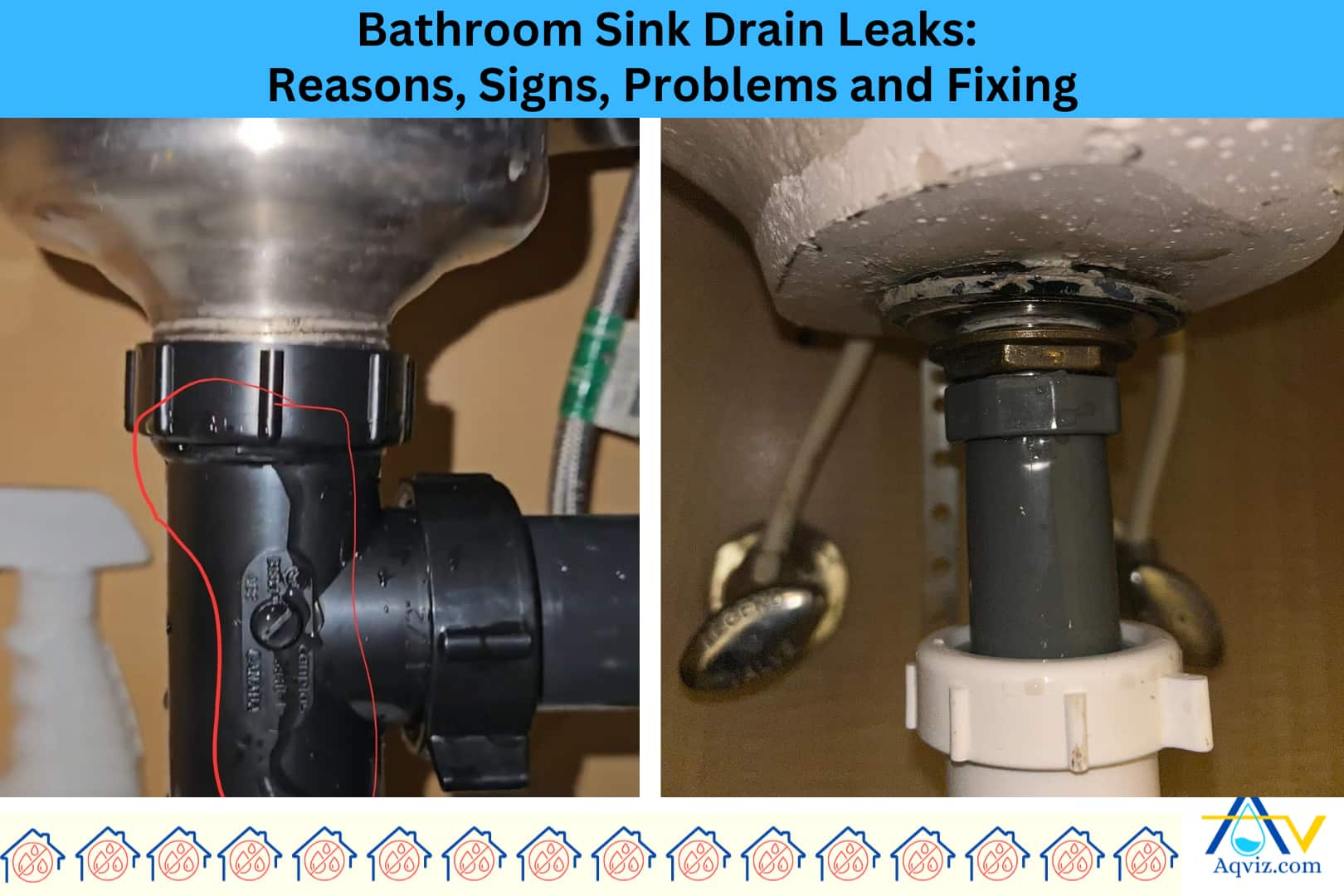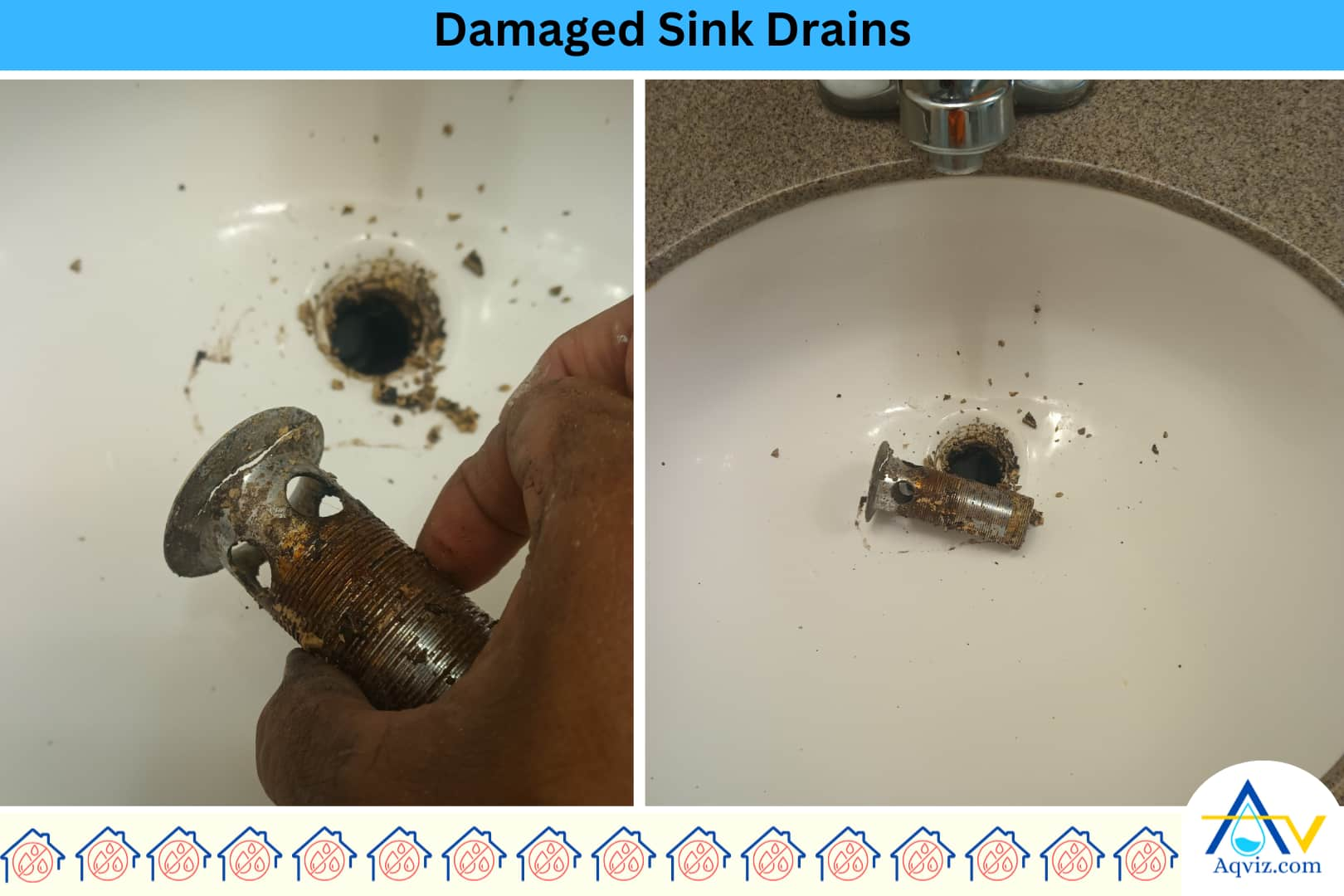Bathroom Sink Drain Leaks: Reasons, Signs, Problems and Fixing

A sink drain leak in the bathroom is water escaping from the drain assembly connected to the sink basin. Sink drain leaks around PVC trap joints, metal tailpieces, gasket seals, or threaded slip nuts. This happens due to loose slip joint connections, deteriorated gaskets, cracked drain pipes, improperly applied plumbers’ putty, and misaligned drain assemblies.
You can find a bathroom sink drain leaking by observing water stains or dampness inside the cabinet, slow or irregular drainage, a mold or mildew smell, corroded or rusted fittings, and visible dripping during water use.
Prolonged sink drain leaking causes damage to the wood fixtures, grow old and mildew, increase musty smell, and deteriorate the bathroom floor. To minimize this serious water damage, Aqviz experts highly recommend that you should waterproof the bathroom floor and under sink area properly. As well as you can seal the drain connection, install a drain pan, and inspect and tighten fittings regularly.
If you visible a sink drain leak, you should follow the below step-by-step guide to fix it. This guide is prepared by the Aqviz expert team, and it includes all the tools, materials, and steps to repair/fix a sink drain leaking in the bathroom.

What is a Sink Drain Leak In The Bathroom?
A sink drain leak in the bathroom is water escaping from the drain assembly connected to the sink basin. Sink drain leaks around PVC trap joints, metal tailpieces, gasket seals, or threaded slip nuts. Bathroom sink drain leaks due to deteriorated plumber’s putty, misaligned P-traps, or cracked ABS couplings. This causes water pooling inside vanity cabinets, musty odors, mold growth, and swelling of MDF boards or laminated surfaces in the bathroom.
Aqviz experts always recommend applying silicone waterproof sealant around the drain fitting, inspecting trap connections regularly, and using water-resistant barriers like HDPE sheets or bitumen-coated underlayment beneath vanities. Bathroom waterproofing helps contain moisture from a sink drain leak, protecting substructures and preventing hidden water damage.
What are the Reasons for Bathroom Sink Drain Leaks?
These are the 5 reasons for a bathroom sink drain leaking.
- Loose slip joint connections
- Deteriorated gaskets
- Cracked drain pipes
- Improperly applied plumber’s putty
- Misaligned drain assemblies
How to Detect a Bathroom Sink Drain Leaking?
To identify the bathroom sink drain leaking, you should observe water stains or dampness inside the cabinet, slow or irregular drainage, mold or mildew smell below the sink, corroded or rusted pipes, and visible drips while using it.
- Water stains or dampness inside the cabinet : If you observe water rings, soft spots, or damp patches inside the vanity cabinet, it is strong evidence that water is escaping from the drain connections during sink use.
- Slow or irregular drainage : When you notice the sink draining more slowly than usual or gurgling, it may signal a partial blockage or poor alignment that causes water to back up and leak at joints or slip nuts.
- Mold or mildew smell below the sink : If you smell musty or sour odors coming from inside the cabinet, it’s a strong signal that standing water from a hidden drain leak has triggered mold growth in the surrounding materials.
- Corroded or rusted fittings : If you observe corrosion on the metal drain pipe, tailpiece, or trap, this visual damage is strong evidence of a long-term leak exposing metal components to constant moisture.
- Visible dripping during water use : When you run water and see drops forming or dripping from the P-trap, tailpiece, or pipe joints, it’s direct evidence of a loose connection, worn washer, or cracked pipe allowing water to escape.
What are the 4 Problems of Sink Drain Leaking in the Bathroom?
There are 4 problems due to sink drain leaking in the bathroom, such as cabinet damage, mold growth, foul odor, and flooring deterioration. If left unchecked, these issues negatively affect both hygiene and structural durability.
- Cabinet and vanity damage : Sink drain leaking allows water to drip directly onto wooden or laminated cabinet bases in the bathroom. Prolonged exposure softens the material, causes swelling, and eventually leads to structural failure of the vanity.
- Mold and mildew under the sink : Leaking drain water creates a moist environment beneath the basin. This trapped moisture encourages mold growth in the bathroom, which affects air quality and poses health risks to the occupants.
- Foul odor from stagnant water : Bathroom sink drain leaks often result in slow accumulation of water inside closed cabinets. This standing water gives off a musty, sour smell that affects the overall freshness of the bathroom.
- Flooring deterioration : Leaking sink water can reach the bathroom floor if undetected. This moisture loosens tiles, stains grout, and seeps into subfloor layers, causing long-term damage and expensive repairs.

How to Minimize the Impact of Bathroom Drain Leaking?
To minimize the impact of bathroom drain leaking, you should waterproof under the sink and around drain fittings and apply proper plumbing practices. Here are 4 effective methods to reduce damage caused by leaking drains in the bathroom.
- Waterproof under the sink area : Applying a liquid-applied waterproofing membrane or installing an HDPE sheet beneath the vanity or cabinet floor helps to prevent water from soaking into wood or drywall in the bathroom.
- Seal all drain connections properly : Using plumber’s putty, thread seal tape, and compression washers around the drain flange and P-trap joints in the bathroom helps to stop water from escaping during use.
- Install a drain pan or moisture barrier : Placing a drain tray liner or plastic moisture barrier under the sink base helps catch minor leaks before they cause staining or mold in the bathroom.
- Inspect and tighten fittings regularly : Checking the P-trap, tailpiece, and slip nuts for movement or wear helps catch early leaks. Regular maintenance prevents unnoticed water escape that can lead to swelling, mold, or odor inside the bathroom.
How to Fix a Sink Drain Leaking in the Bathroom?
To fix a sink drain leaking in the bathroom, you should follow the 5-step guide below. Aqviz experts apply these steps on every drainage repair project to ensure long-term sealing and water-tight performance. These steps help you work efficiently and avoid recurring leaks over time.
- Identify the leak location: First, you should start by running water through the sink and using a flashlight to inspect all drain connections. If needed, you can wrap toilet tissue around the tailpiece, P-trap, and slip joints to detect exactly where moisture escapes.
- Remove the drain assembly: Using channel-lock pliers or basin wrench, you can disconnect the tailpiece, P-trap, and drain flange. You should always place a bucket under the sink to catch trapped water and avoid spills during disassembly.
- Clean all parts and sealing surfaces : You should thoroughly clean the drain flange, rubber washers, and drain threads using a wire brush and vinegar or degreaser. Removing old plumber’s putty and buildup ensures the new seal will sit flush and leak-free.
- Reseal and reinstall the drain: You should apply fresh plumber’s putty or silicone sealant under the drain flange and reinstall it into the sink. Then you should reconnect the tailpiece, trap arm, and compression nuts, making sure to hand-tighten snugly with slip joint pliers to avoid overtightening.
- Test for leaks : After everything is reconnected, you should run water for 2-3 minutes and wipe all joints with a dry towel. If no moisture appears, you can confirm the leak is resolved and the drain is functioning properly.
Aqviz Experts have investigated all of the bathroom water damages and listed out the 8 most common water damage in the bathroom and prepared a complete guide for each water problem with including reasons, signs, problems, and how to fix it properly as an expert. So we highly recommend you to refer to all of these 8 bathroom problems.
- Bathroom Faucet Leak
- Hot Water Leak
- Toilet Leak
- Bathroom Sink P Trap Leak
- Bathtub Overflow
- Cracked Shower Tray
- Bathroom Broken Tiles
- Bathroom Mold
Where to Connect Sink Drain?
The sink drain connects to the P-trap, which then connects to the branch drain pipe inside the bathroom wall or floor. Hence, you should always align the tailpiece from the sink vertically into the P-trap inlet, and the trap arm is fitted into the drain stub-out. A properly aligned sink drain helps to smooth water flow and prevent leaks or clogs.
Should you Waterproof the Bathroom Before Installing the Sink Drain?
Yes, you should waterproof the bathroom surface before installing the sink drain. You should always apply a liquid waterproofing membrane or HDPE sheet under vanities and around pipe penetrations. This prevents water from leaking into the cabinet base, wall cavity, or flooring, especially if the P-trap or tailpiece ever loosens or leaks.
What If Sink Drain Damage in The Bathroom?
If the sink drain is damaged, it can cause slow leaks, cabinet rot, mold growth, or foul odors. At Aqviz, we recommend turning off the water supply, removing the faulty section with slip-joint pliers, and replacing worn-out washers, tailpiece, or trap assembly. Delaying repairs leads to costly moisture damage and unhealthy indoor conditions.
